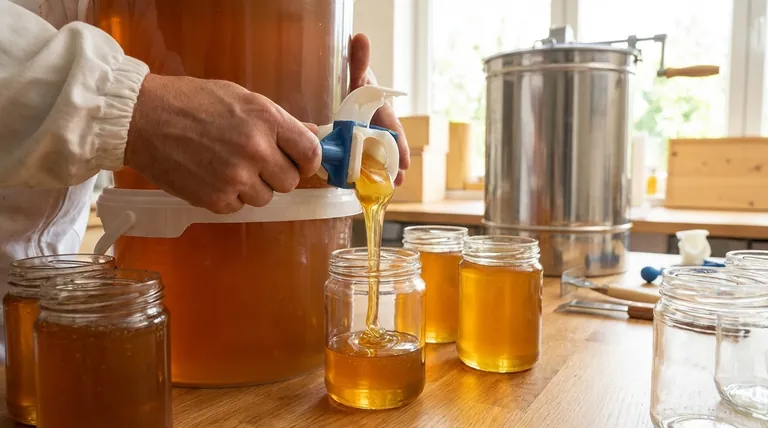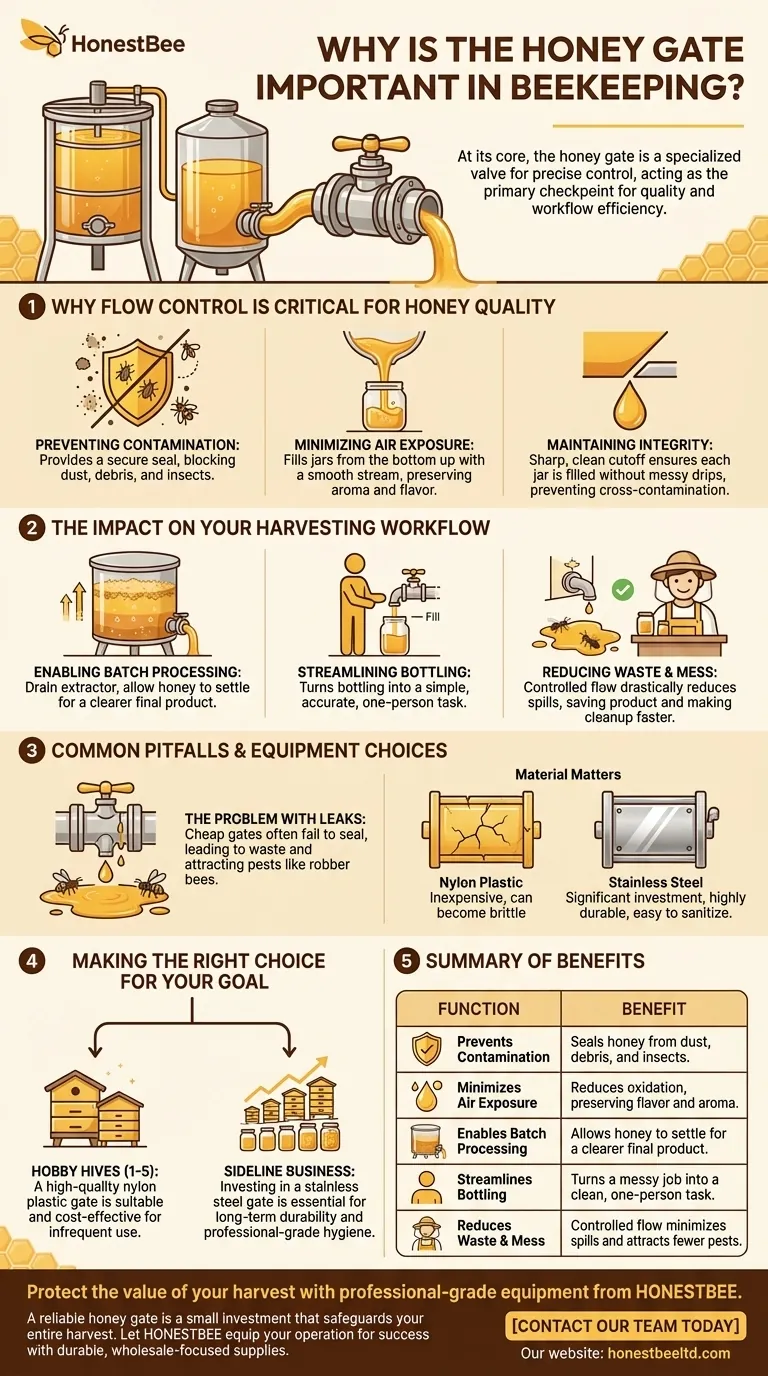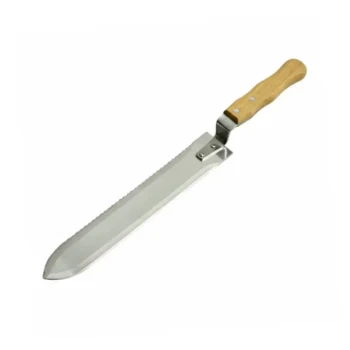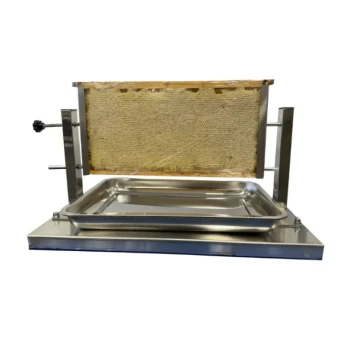At its core, the honey gate is a specialized valve that gives a beekeeper precise control over honey as it flows from an extractor or bottling tank. It is a simple but essential tool that protects the integrity and freshness of the final product by preventing contamination and making the entire extraction process more efficient and less messy.
The honey gate is not merely a tap; it is the primary checkpoint for quality control and workflow efficiency. Its function is to transform a potentially chaotic, sticky process into a controlled, clean, and professional operation, safeguarding the honey you've worked all season to produce.

Why Flow Control is Critical for Honey Quality
The moment honey leaves the extractor is when it's most vulnerable. A honey gate mitigates the primary risks to your harvest: contamination and degradation.
Preventing Contamination
A honey gate provides a secure seal on your extractor or bottling bucket. This prevents dust, debris, insects, or other airborne contaminants from entering the honey while it settles.
Without a gate, you are forced to use an open-top system, which leaves your honey exposed for extended periods.
Minimizing Air Exposure
Pouring honey from a large container introduces significant amounts of air, creating foam and bubbles. A honey gate allows you to fill jars from the bottom up with a smooth, steady stream.
This gentle process minimizes oxidation and preserves the delicate aromas and flavors of the honey.
Maintaining Honey's Integrity
The sharp, clean cutoff provided by a quality honey gate ensures that each jar is filled without messy drips.
This is more than just an issue of cleanliness; it prevents the cross-contamination that can occur when honey drips onto work surfaces and is inadvertently mixed back into your batch.
The Impact on Your Harvesting Workflow
Beyond quality, the honey gate is a fundamental tool for efficiency. It streamlines the entire process from extraction to bottling, saving time and reducing frustration.
Enabling Batch Processing
A honey gate allows you to drain your extractor into a bottling tank or bucket and then walk away.
This lets the honey settle, allowing wax cappings and air bubbles to rise to the surface naturally before you begin bottling, ensuring a clearer final product.
Streamlining Bottling
Attempting to bottle honey by tipping a heavy, 5-gallon bucket is a recipe for disaster. It is a slow, messy, and often a two-person job.
A honey gate turns bottling into a simple, one-person task. It gives you the on-off control needed to fill jars quickly, accurately, and cleanly.
Reducing Waste and Mess
Every drop of spilled honey is wasted product and a magnet for pests like ants and robber bees. The controlled flow from a honey gate drastically reduces spills.
This makes cleanup significantly faster and prevents the frustrating loss of your hard-earned honey.
Common Pitfalls and Equipment Choices
Not all honey gates are created equal. The most common mistake a beekeeper can make is choosing a low-quality gate to save a few dollars, which often leads to greater costs down the road.
The Problem with Leaks
Cheaply made gates often fail to create a perfect seal. A slow, constant drip is incredibly wasteful and will attract pests from all over the neighborhood, potentially inciting robbing behavior that can devastate weaker hives.
Material Matters: Plastic vs. Steel
Most honey gates are either nylon plastic or stainless steel. Plastic gates are inexpensive but can become brittle over time and may be harder to clean perfectly.
Stainless steel gates are a significant investment but are far more durable, easier to sanitize, and will last a lifetime.
The Importance of a Clean Cutoff
A poorly designed gate will not close sharply, leaving a final string of honey that drips onto your jar and work surface. This small detail can add hours of cleanup time to a large bottling session.
Making the Right Choice for Your Goal
Your equipment should always match the scale of your operation.
- If your primary focus is harvesting from 1-5 hobby hives: A high-quality nylon plastic gate is a perfectly suitable and cost-effective choice for infrequent use.
- If your primary focus is growing into a sideline business: Investing in a stainless steel gate for your bottling tank is essential for long-term durability and professional-grade hygiene.
Ultimately, a reliable honey gate is a small investment that pays for itself by protecting the quality and value of your entire honey harvest.
Summary Table:
| Function | Benefit |
|---|---|
| Prevents Contamination | Seals honey from dust, debris, and insects. |
| Minimizes Air Exposure | Reduces oxidation, preserving flavor and aroma. |
| Enables Batch Processing | Allows honey to settle for a clearer final product. |
| Streamlines Bottling | Turns a messy job into a clean, one-person task. |
| Reduces Waste & Mess | Controlled flow minimizes spills and attracts fewer pests. |
Protect the value of your harvest with professional-grade equipment from HONESTBEE.
As a trusted supplier for commercial apiaries and beekeeping equipment distributors, we understand that your honey's quality is your reputation. A reliable honey gate is a small investment that safeguards your entire harvest from contamination and waste.
Let HONESTBEE equip your operation for success. We provide durable, wholesale-focused beekeeping supplies designed for efficiency and long-term performance.
Contact our team today to discuss your equipment needs and discover how we can support your business growth.
Visual Guide

Related Products
- Honey Gate Valve with Ergonomic Ball Handle Plastic Bee Honey Tap for Beekeeping Bottling and Honey Extractor Equipment
- Professional Thermostatic Conical Honey Melter
- High Quality Honey Dehumidifier Dryer Thickening Machine for Beekeeping
- Honey Concentrating Vacuum Heating Thickening Machine Dehumidifier for Honey
- Economy Small Scale Honey Dryer Dehumidifier Thickening Machine
People Also Ask
- What are the advantages of using a honey gate? Achieve Clean, Efficient Honey Bottling
- What is the Flow Hive and how does it simplify honey extraction? A Gentle, On-Demand Harvesting Solution
- How does the Flow Hive reduce labor for beekeepers? A Guide to Effortless Honey Harvesting
- How does the Auto Flow Hive improve honey production? By Minimizing Hive Disruption for Higher Yields
- Can a honey gate be reused, and how should it be stored? Ensure Longevity for Your Honey Harvests



















